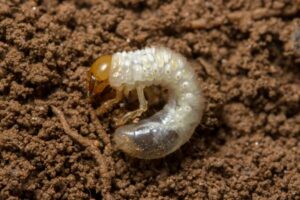Japanese Beetle Grubs in Turf
go.ncsu.edu/readext?879160
en Español / em Português
El inglés es el idioma de control de esta página. En la medida en que haya algún conflicto entre la traducción al inglés y la traducción, el inglés prevalece.
Al hacer clic en el enlace de traducción se activa un servicio de traducción gratuito para convertir la página al español. Al igual que con cualquier traducción por Internet, la conversión no es sensible al contexto y puede que no traduzca el texto en su significado original. NC State Extension no garantiza la exactitud del texto traducido. Por favor, tenga en cuenta que algunas aplicaciones y/o servicios pueden no funcionar como se espera cuando se traducen.
Português
Inglês é o idioma de controle desta página. Na medida que haja algum conflito entre o texto original em Inglês e a tradução, o Inglês prevalece.
Ao clicar no link de tradução, um serviço gratuito de tradução será ativado para converter a página para o Português. Como em qualquer tradução pela internet, a conversão não é sensivel ao contexto e pode não ocorrer a tradução para o significado orginal. O serviço de Extensão da Carolina do Norte (NC State Extension) não garante a exatidão do texto traduzido. Por favor, observe que algumas funções ou serviços podem não funcionar como esperado após a tradução.
English
English is the controlling language of this page. To the extent there is any conflict between the English text and the translation, English controls.
Clicking on the translation link activates a free translation service to convert the page to Spanish. As with any Internet translation, the conversion is not context-sensitive and may not translate the text to its original meaning. NC State Extension does not guarantee the accuracy of the translated text. Please note that some applications and/or services may not function as expected when translated.
Collapse ▲White grubs are the larvae of scarab beetles, which include the Japanese beetle. They are the grubs that I receive the most calls about and are consistently the most economically damaging grub in North Carolina
Japanese beetle grubs have cream-colored bodies with yellow to brownish heads, brownish hind parts, and six legs. Mature grubs can be up to 1 ¼ inches long and are usually in a curled or C-shaped position.
Recent studies indicate that traps for Japanese beetle adults have no real impact on the subsequent population of grubs in the soil. The use of Japanese beetle traps can also attract the foliage-feeding adults into areas where they may feed on ornamental landscape plants.
A biological treatment method, useful against only Japanese beetle grubs, is the application of milky spore bacteria. This commercially available bacteria, when applied to the soil, infects the grubs and produces a disease. Grubs in the soil come in contact with the spores through ingestion. The spores germinate inside the grubs, eventually killing them. These spores work best when applied in late September or early October to soil with a pH level between 6 and 7. Control is not as rapid as with chemical insecticides, but the effects last many years. Milky spore is sold under trade names such as Doom®, Japidemic®, or Milky Spore.
The timing of a chemical insecticide application is critical if control is to be effective. There are two approaches, preventative and curative. Some of the newer products (Merit® and Mach 2®) are preventative, and are most effective when applied prior to when the eggs are laid. This approach should only be used in areas that have a history of grub infestations. The curative approach is used when an existing infestation is detected. The best time to apply curative insecticides is when the grubs are actively feeding near the soil surface. Pesticides applied any other time will be ineffective. Feeding close to the soil surface occurs from August through October, and again from April through early May. Curative treatments applied in late summer or fall are usually more effective than spring applications because the grubs are small and more susceptible to the insecticide.
Irrigation prior to application is highly recommended, especially in dry weather. Grubs move deeper in the soil when conditions are dry, and irrigation a day or two before application helps to bring them closer to the surface and improves control. Insecticides kill grubs more effectively if watered in after application. No matter which product or approach is selected, be sure to follow label directions.





